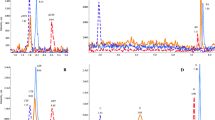Abstract
5-hydroxymethyluracil was originally identified as an oxidatively modified DNA base derivative. Recent evidence suggests that its formation may result from the oxidation of thymine in a reaction that is catalyzed by TET proteins. Alternatively, it could be generated through the deamination of 5-hydroxymethylcytosine by activation-induced cytidine deaminase. The standard method for evaluating 5-hydroxymethyluracil content is the highly sensitive and highly specific isotope-dilution automated online two-dimensional ultraperformance liquid chromatography with tandem mass spectrometry (2D-UPLC-MS/MS). Despite many advantages, this method has one great limitation. It is not able to measure compounds at a single-cell level. Our goal was to develop and optimize a method based on flow cytometry that allows the evaluation of 5-hydroxymethyluracil levels at a single cell level in peripheral leukocytes.
Access this chapter
Tax calculation will be finalised at checkout
Purchases are for personal use only
Similar content being viewed by others
References
Madugundu GS, Cadet J, Wagner JR (2014) Hydroxyl-radical-induced oxidation of 5-methylcytosine in isolated and cellular DNA. Nucleic Acids Res 42:7450–7460
Olinski R, Starczak M, Gackowski D (2016) Enigmatic 5-hydroxymethyluracil: oxidatively modified base, epigenetic mark or both? Mutat Res Rev Mutat Res 767:59–66
Neuhard J, Maltman KL, Warren RA (1980) Bacteriophage phi W-14-infected Pseudomonas acidovorans synthesizes hydroxymethyldeoxyuridine triphosphate. J Virol 34:347–353
Witmer H (1981) Synthesis of deoxythymidylate and the unusual deoxynucleotide in mature DNA of Bacillus subtilis bacteriophage SP10 occurs by postreplicational modification of 5-hydroxymethyldeoxyuridylate. J Virol 39:536–547
Pfaffeneder T, Spada F, Wagner M et al (2014) Tet oxidizes thymine to 5-hydroxymethyluracil in mouse embryonic stem cell DNA. Nat Chem Biol 10:574–581
Branco MR, Ficz G, Reik W (2012) Uncovering the role of 5-hydroxymethylcytosine in the epigenome. Nat Rev Genet 13:7–13
Gou JU, Su Y, Zhong C et al (2011) Hydroxylation of 5-methylcytosine by TET1 promotes active DNA demethylation in the adult brain. Cell 145:423–434
Raiber EA, Hardisty R, van Delft P et al (2017) Mapping and elucidating the function of modified bases in DNA. Nat Rev Chem 1. https://doi.org/10.1038/s41570-017-0069
Gackowski D, Starczak M, Zarakowska E et al (2016) Accurate, direct, and high-throughput analyses of a broad spectrum of endogenously generated DNA base modifications with isotope-dilution two-dimensional ultraperformance liquid chromatography with tandem mass spectrometry: possible clinical implication. Anal Chem 88:12128–12136
Adan A, Alizada G, Kiraz Y et al (2017) Flow cytometry: basic principles and applications. Crit Rev Biotechnol 37:163–176
Brandy HJ (2014) Apoptosis methods and protocols. Humana Press, Totowa
Sasaki K, Adachi S, Yamamoto T et al (1988) Effects of denaturation with HCl on the immunological staining of bromodeoxyuridine incorporated into DNA. Cytometry 9:93–96
Bikoue A, Janossy G, Barnett D (2002) Stabilised cellular immuno-fluorescence assay: CD45 expression as a calibration standard for human leukocytes. J Immunol Methods 266:19–32
Dagur PK, McCoy JP (2015) Collection, storage, and preparation of human blood. Cells Curr Protoc Cytom 73:5.1.1–5.1.16
Acknowledgments
This work was supported by the Polish National Science Centre (2018/29/N/NZ5/02375).
Author information
Authors and Affiliations
Corresponding author
Editor information
Editors and Affiliations
Rights and permissions
Copyright information
© 2021 The Editor(s) (if applicable) and The Author(s), under exclusive license to Springer Science+Business Media, LLC, part of Springer Nature
About this protocol
Cite this protocol
Gackowska, L., Labejszo, A., Gackowski, D. (2021). Analysis of 5-Hydroxymethyluracil Levels Using Flow Cytometry. In: Ruzov, A., Gering, M. (eds) DNA Modifications. Methods in Molecular Biology, vol 2198. Humana, New York, NY. https://doi.org/10.1007/978-1-0716-0876-0_21
Download citation
DOI: https://doi.org/10.1007/978-1-0716-0876-0_21
Published:
Publisher Name: Humana, New York, NY
Print ISBN: 978-1-0716-0875-3
Online ISBN: 978-1-0716-0876-0
eBook Packages: Springer Protocols




